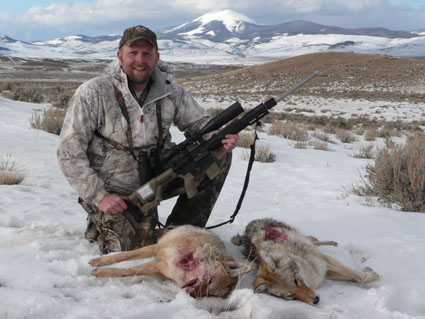We quietly rolled down the backcountry roads searching for our next stand. In the distance we saw what appeared to be an ideal spot. It was a high knoll with spotted sagebrush and cedar trees only a few hundred yards from the road.
On the other side of the knoll, sagebrush-lined draws ran toward the cedar foothills. We parked the truck where it couldn’t be seen, crept into our stand, and started calling. I scanned the area intently. After each sequence of calls I anticipated the appearance of a coyote running to the dinner bell we were ringing.
Much to my surprise, 30 minutes of calling in this “perfect” spot produced nothing. Not even a crow or magpie. What did we do wrong? Why didn’t they come to the call?
This was a common tale for me as a novice predator hunter. I can’t tell you how many times I called the “perfect” looking stand and called nothing. Once in a while I’d get lucky, but most times the outcome was the same. It was back to the truck empty handed and off to look for the next great-looking stand.
My stand selection process is very different today than it was two decades ago when I started calling predators. Through trial, error, and experience, I’ve learned ways to greatly increase my calling success. Hopefully these pointers and ideas will help you as well.
Hunt Where Coyotes Are
The most important ingredient in my coyote calling stew is location. There are several factors to consider as part of every stand including sun, wind, sounds, equipment and more.
However, none of them matter if there aren’t coyotes in the area I’m calling. I’ve learned that in order to consistently call and kill coyotes I must be where they are.
There are a couple of keys here. First, scouting and locating coyotes is imperative. Second, I must be willing to call them regardless of what the countryside looks like.
Think Outside The Box
As predator hunters we tend to gravitate towards terrain that has been successful for us in the past. I spent many years hunting the deserts of Utah and Nevada. Nothing looks more inviting to me than thick sage and cedar foothills. For others it might be CRP fields, wide-open grasslands, or badlands that get your attention.
In order to be a complete predator hunter you must think outside the box. We limit ourselves when we look for specific terrain to hunt, rather than focusing on coyote location. Coyotes can be called and killed in any terrain. I have found that most predator hunters are searching for the same “perfect” stand.
Oftentimes doing something different is all it takes to have an amazing day in the field. If you know there are coyotes in the area, be creative and engineer a plan to call them, regardless of terrain.
 The author with three coyotes called and killed in wide-open country in Montana. |
Strategies
Here are some strategies that work well for me in various types of terrain. My “perfect” stand is a small hill overlooking a sagebrush and cedar tree valley. I like to rest my back against a sage bush for comfort and concealment. This scenario is not always available so here are some other setups you might consider.
In dense cover such as thick sage, cedar pockets, or pine pockets, sitting back to back with a partner works well. I always carry a shotgun to these stands. I’ve had some incredible days in this type of country. These areas are often overlooked by other callers.
In wide-open country I like to lay on my belly with a bi-pod. I typically position the electronic caller and decoy 30 to 50 yards up-wind and stay as still as possible. Good camouflage is imperative in this scenario. If I’m hunting with a partner, we watch different directions to cover more area.
When I’m hunting steep canyons I like to sit on the opposing hillside from my partner. This gives us the ability to cover more area than if we were sitting side-by-side. The coyotes can come from anywhere in this type of terrain. For safety sake you must know exactly where your partner is.
The Perfect Stand
Over the years my definition of the perfect stand has changed. It really has nothing to do with the terrain, but where the coyotes are located. Nothing is more challenging than coming up with new strategies for calling predators.
At the same time, nothing is sweeter than being creative and outsmarting a predator on their own turf. You might find that thinking out of the box will broaden your horizons and open up more areas to call coyotes.
About The Author
Dustin has been calling predators for more than 20 years. He has competed in coyote calling contests around the western U.S. for more than a dozen years and has consistently excelled including many wins and top finishes. He enjoys sharing his knowledge of predator hunting with others through calling seminars and magazine articles. To learn more about Dustin or the equipment he uses visit www.predatordown.com.






